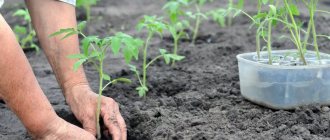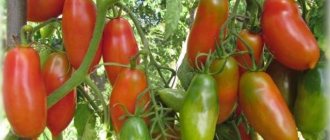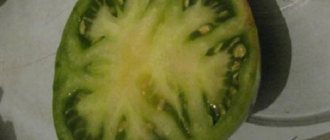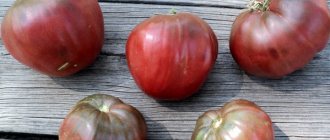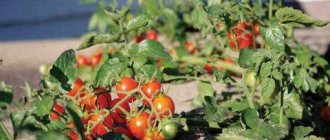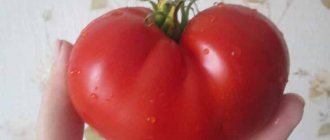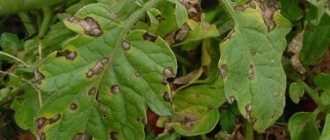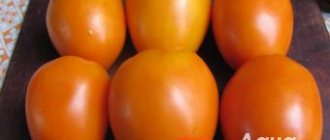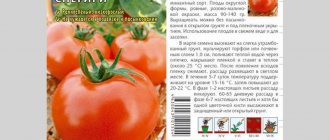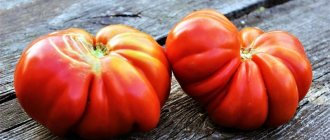| Ripening period: | mid-early (110-120 days from emergence) |
| Shape, weight of fruits: | plum-shaped, weight 30-50 g |
| Determinacy: | tall (up to 220 cm) |
| Growing regions: | throughout Russia |
| Productivity: | 4-6 kg per plant |
Protected soil will help you get a stable harvest of vegetables in short and cold summers. Tomato varieties for greenhouses have different requirements than for plants for open ground. Among tall greenhouse cultivars, the Chio-chiosan tomato is especially popular among gardeners.
Description and characteristics of the variety
According to the description, Cio-chio-san tomatoes belong to the indets. The length of the stem reaches 2-2.2 m, so the bush must be tied to a support. Domestic variety, bred in 1998. The organizer is the Gavrish company.
The variety bears fruit in a cluster; each cluster can contain several dozen fruits. The total weight of the bunch can exceed 2 kg, so each cluster is also tied to a trellis.
Chio-chio-san tomatoes ripen 120-127 days after sowing the seeds in the ground. The fruits have the shape of cream, are covered with a smooth dense skin of red-pink color with a small green spot near the stalk, weight - 40-50 g. The pulp is tender, sweet taste, very juicy.
Cio-chio-san is suitable for whole-fruit canning, preparation of tomato juice, and fresh use.
The presented photo shows how many fruits cover the tomato bush. The yield is quite high; up to 6 kg of small, tasty tomatoes are harvested from each plant in the greenhouse.
The Chio-chio-san variety is resistant to late blight, tobacco mosaic virus, and fruit cracking.
The cultivar can be grown indoors and outdoors (limiting the growth of bushes to a height of 150-170 cm), but the most significant harvest is obtained from greenhouse plants.
Subtleties of growing tomatoes
Highly fertile, light soils are suitable for growing tomatoes. Favorable predecessors for nightshades are pumpkin crops, cabbage, onions, cucumbers and carrots. You should not use areas where potatoes, eggplants, peas and peppers previously grew for planting tomatoes. Growing of tomato crops is carried out using the seedling method.
See also Characteristics and descriptions of Koenigsberg tomato varieties - Golden, Heart-shaped, New Pink and Striped
Seed preparation
You should buy seeds in specialized stores. Before sowing, planting material requires preparation, which consists of the following manipulations:
- Calibration - seeds are soaked in water and set aside for a short time. After 5 minutes, the water with the floating seeds is drained. The seeds that have sunk to the bottom are dried.
- Disinfection - calibrated seed material is soaked and kept in a solution of potassium permanganate. To prepare a disinfectant composition, 1 g of potassium permanganate is diluted in a liter of water. Seeds wrapped in gauze are kept in the solution for 15–20 minutes.
- Hardening - seeds are alternately exposed to high and low temperatures.
Container and soil
Soil preparation is an important stage in the process of growing vegetable seedlings. For sowing seeds, water- and air-permeable soil compositions are used. The ideal basis for sowing tomatoes is turf soil, half mixed with peat and humus. To reduce acidity, wood ash is added to the mixture at the rate of 200 grams per bucket of soil. Special trays or cassettes, plastic or wooden boxes are used as containers for growing seedlings.
Sowing
Sowing seeds for seedlings is carried out in March. The selected containers for sowing are filled with soil composition, the thickness of the soil layer is from 5 cm. The prepared seeds are placed in moistened soil to a depth of 1–2 cm. The containers are covered with film and left warm. The first seedlings appear on the 5th day after sowing. After germination of the seed, the film is removed.
Seedling care
Seedlings are cared for in accordance with key agrotechnical rules. Basic conditions for growing seedlings:
- regular moistening of the soil mixture;
- sufficient level of illumination;
- maintaining optimal air temperature and humidity;
- loosening the soil.
Expert opinion
Stanislav Pavlovich
Gardener with 17 years of experience and our expert
Ask a Question
Important! After the first pair of true leaves appear on the sprouts, the seedlings are plucked, that is, planted in individual containers with preliminary pinching off the main root by a third.
Transplantation to a permanent place
Seedlings are usually planted in May or June. Seedlings suitable for planting in a permanent place should reach a height of 20–35 cm. Good planting material should have a thick stem.
On a note! 10 days before planting in a permanent place, the seedlings are hardened.
Holes in the soil are prepared immediately before planting seedlings. Planting norms per 1 m2 of plot are from 3 to 5 bushes. The distance between the rows is 60–70 cm, the bushes in the row are planted at a distance of 45–60 cm from each other.
Features of cultivation and care
Sowing seeds of mid-season varietal tomatoes is carried out in February or March. The exact period depends on the time of planting seedlings in open beds or in a greenhouse.
By the time the seedlings are placed in a permanent place, their age should be 60-65 days.
Tomato seedlings are planted in open ground when the average daily temperature reaches +17 +19 degrees.
Cio-chio-san grows quickly, so it is recommended to immediately sow the seeds in separate glasses. As they grow, the seedlings are planted into a larger container, burying the stem in the soil down to the cotyledons.
To prevent seedlings from stretching, it is necessary to provide them with additional lighting. The tomatoes are illuminated with phytolamps, extending the daylight hours to 12 hours.
Cio-chio-san is placed on the garden bed at a distance of 40-45 cm from each other. Simultaneously with planting the seedlings, stakes are installed next to the bushes or wire is pulled to tie up the plants.
Caring for Cio-chio-san is not difficult. Plants need to be watered, fed and properly shaped.
Tomatoes are watered every 3-4 days, soaking the soil to a depth of 20-25 cm. The water used is not cold, soft (rain, river, settled tap water). Tomatoes should be watered at the roots, without touching the foliage (plants cannot tolerate high air humidity).
The greenhouse bushes are formed into one stem, removing all the resulting stepsons. Side shoots are pinched when they have grown to a length of 1.5-2 cm.
Tomatoes located in open ground are formed into 2 stems, leaving the first strong stepson on each plant. At a height of 150-170 cm, pinch the top of the bush, limiting the growth of the tomato.
After setting fruit on the first flower cluster, the leaves growing below it are removed.
Without timely application of fertilizers, obtaining a bountiful harvest in a greenhouse is impossible. Cio-chio-san is fed every 2 weeks, starting from the moment the seedlings are planted in the garden.
They use ready-made mixtures of mineral fertilizers for tomatoes (OMU, Fertik, Fasco, Gera) or make compositions based on folk remedies.
Simple recipes made from available products get good reviews from gardeners: an infusion of banana skins, grain fertilizer, a solution of iodine and boric acid, an extract from vermicompost.
Harvesting for storage and transportation should be done at the technical ripeness stage. The fruits are pale pink in color and have a dense structure. In this condition they can be transported or stored in a cool place for up to 4 weeks.
Care after landing
In the future, caring for these tomato bushes is standard: you need to carry out regular watering, weed and loosen the root zone of the plants, apply fertilizer several times a season, form the bushes, and also tie up the shoots as they grow. As the fruits in the clusters ripen, it is necessary to place supports under them.
The tops of the bushes should be pinched when they reach the top of the greenhouse. As the bushes ripen, it is necessary to tear off the foliage of the tomatoes, starting with the lower leaves. And by the time the fruits begin to ripen, there is practically no foliage left on the bushes.
Related article:
Tomato Verochka F1 - description and characteristics of a super early variety
Diseases and pests
The characteristics and description of the Chio-chio-san variety indicate the plant’s resistance to common tomato diseases. However, the bushes must be inspected regularly.
If brown spots or pockets of mold appear on the foliage and fruits, the tomatoes are immediately treated with antifungal drugs. The following fungicides are used to spray plants on private farms:
- Fitosporin;
- Trichodermin;
- Previkur;
- Fitolavin.
The spraying solution is prepared in strict accordance with the instructions, the frequency of treatments is 2-3 per season.
In open ground, tomato bushes are plagued by aphids, Colorado potato beetles, whiteflies, and slugs. In a greenhouse, there is a high probability of tomatoes being damaged by spider mites.
Infusions of tobacco, ash, garlic, wormwood, and soapy water are used against pests. When the number of insects is high, insecticides are used: Imidor, Confidor, Aktara, Fitoverm, Akarin.
Flaws
Among the disadvantages it should be noted:
- since this tomato is a hybrid, it is impossible to collect seed material for subsequent planting;
- bushes of this variety do not tolerate sharp drops in air temperature;
- bushes require shaping and gartering; brushes also need to be tied up;
- if ripe fruits are left on the bushes, they may crack.
Related article:
The earliest varieties of tomatoes: types and descriptions
Advantages and disadvantages
Vegetable growers value Chio-chio-san for its unpretentiousness and resistance to disease. The tomatoes have a good presentation, they are smooth, even in size, and tasty. This is one of the best varieties for canning.
The disadvantages of the cultivar include its tallness and fragility of the stem. If you don't pay enough attention to the garter, it may break under the weight of the tomatoes.
If there is excess moisture in the soil, the skin of tomatoes may become cracked.
Tomatoes Chio Chio San on video
Producer of seeds of this variety: agricultural company Gavrish.
If you grew Cio-Cio-San tomatoes, please write whether you liked them or not. What was the yield and taste of the fruits in your climatic conditions? Will you grow them again? How do you rate the disease resistance of this tomato? Briefly describe the advantages and disadvantages of this tomato in your opinion. If possible, attach a photo of the entire bush or individual fruits you grew to your comment. Thank you!
For other interesting varieties with photos, descriptions and reviews, see our Tomato Catalog alphabetically. Enjoy watching!
Your reviews of the Chio Chio San tomato and additions to the description will help many gardeners evaluate this variety more objectively and decide whether it is worth planting or not.
Similar varieties
Without the opportunity to buy the original variety, you can grow tomatoes similar in key characteristics to Chio-chio-san:
- Grozdevoy. An early ripening hybrid tomato, 220-260 cm high. Fruits, weighing 70-90 g, are formed in clusters, 6-8 pieces each. The tomatoes are red, oval-shaped, with a spout at the top. The taste is sweet, the flesh is dense. Plants are resistant to heat, stress and cracking. The hybrid is recommended for growing indoors.
- Adjutant. Tall hybrid for greenhouses. The crop ripens 115 days after germination. The fruits are red, elongated, similar to cigars, weighing 80-100 g. Average yield is 4.5 kg per plant.
- Amish red. The height of the tomato stem is 140-150 cm. It is recommended to form the bush into 2-3 stems, tying the shoots to supports with a fan. The tomatoes are plum-shaped and grow in clusters of 5-6 pieces. Their weight is 70-90 g. The pulp is dense, with a small amount of juice, sweet.
- Lollipop. An early ripening variety (the harvest ripens 90-100 days after emergence) suitable for growing in greenhouses and open ground. The fruits are red, oval, 5-8 in a cluster. The weight of tomatoes is up to 50 g. The largest fruits are formed on the lower clusters. The taste of the pulp is sweet, with a pronounced tomato aroma.
- Octopus raspberry cream. Hybrid 2.5 m high, for placement in a greenhouse. Up to 8 bunches are formed on the bush, each containing 8-10 plum-shaped tomatoes weighing up to 100 g. The flesh is dense, the skin is strong, the taste is sweet and sour. The hybrid is resistant to major tomato diseases, drought and heat.
Main advantages
The main positive qualities of this variety include:
- good yield of the variety;
- resistance to periods of drought and heat;
- the hybrid can be grown in partial shade;
- high resistance to most diseases;
- versatility of the harvested crop;
- pleasant taste and good appearance of the collected fruits;
- friendly return of the harvest;
- The collected fruits tolerate transportation well over different distances and have good shelf life.
Features of care
Caring for Cio Cio San tomatoes consists of the following procedures:
- watering;
- feeding;
- stepsoning;
- garter;
- loosening the soil;
- weeding;
- hilling.
Fertilizer and watering
A variety of fertilizers are used to feed tomatoes:
- mineral (ammonium nitrate, ammonium sulfate, ammonium sulfate, urea, superphosphate, potassium salt);
- organic (mullein, compost, bird droppings);
- complex (“Kemira Universal-2”, “Kemira Lux”, “Solution”, “Universal”, “Potassium Monophosphate”);
- yeast and grass supplements.
3-4 feedings per season will be required:
| Term | Fertilizer |
| After 14–20 days after moving the seedlings into the ground | 40 g of phosphorus-containing fertilizers + 15 g of potassium + 25 g of nitrogen + 10 l of water. Working fluid consumption - 1 l/1 bush |
| When the flowers appear | 0.5 liters of mullein or bird droppings + 1 tbsp. l. potassium sulfate + 10 liters of water or nitrophosk, “Solution”, “Kemira-universal” |
| During the formation of the ovary | Wood ash infusion (2 l/10 l hot water) + 10 g boric acid |
| In the phase of mass fruiting | 2 tbsp. l. superphosphate + 1 tbsp. l. sodium humate + 10 l of water |
It is recommended to alternate root feeding with foliar feeding. The best foliar bait for tomatoes is considered to be yeast.
It is prepared by mixing:
- 10 g dry yeast;
- 0.5 liters of wood ash;
- 5 tbsp. l. Sahara;
- 10 liters of water.
Tomato bushes are treated at the stage of budding and blooming of the first flowers.
For the first time after planting, tomato bushes are watered 10–12 days later. Use warm, settled or rainwater with a temperature of at least +20 °C.
Before flowers begin to appear, approximately 4 liters of water will need to be consumed per 1 m². In the phase of flower blooming and ovary formation - up to 12 liters.
The optimal watering regime for tomatoes is 1-2 times every 7 days. The best time to moisturize is in the evening, after the sun has gone down, or on a cloudy day. When watering, you must ensure that moisture does not fall on the foliage and stems. This will prevent the development of burns on plants.
Tomatoes can be watered manually - using a hose (under the root, excluding moisture from entering the organs of the bush) and using the subsoil drip method. Drip irrigation is more preferable, convenient, efficient and economical.
Important! Fertilizers are applied to the roots only after abundant watering.
Since tomatoes do not tolerate either drought or waterlogging, it is necessary to ensure that they are watered in moderation. In order to find out whether the plants are well watered, gardeners use the following method: they squeeze a lump of soil in their fist, removed from a depth of 10 cm. If it molds well into a mold and falls apart, then watering is sufficient.
Bush formation and pinching
It is imperative to plant Cio Cio San tomatoes. Without this procedure, the yield level will significantly decrease; without garter, the stems will lie on the ground and break.
As the tomato bush grows, it forms many side shoots or stepsons. Their large number leads to:
- thickening of plantings;
- development of diseases caused by fungi;
- the formation of small fruits or their late ripening.
To avoid these problems, pinching is carried out, i.e., removing lateral shoots growing in the axils of the leaves. They are torn off by hand or cut off with scissors, leaving 5 cm “stumps”. As a result, only one main stem should remain. 2 stems are also allowed.
The sooner additional stepsons are removed, the better the harvest will be obtained. It is necessary to carry out pinching 1-2 times a week. In addition to cutting off the side shoots, they also remove the lower leaves that come into contact with the ground. This will prevent the development of diseases.
We recommend reading about the “Wonder of the World” tomato variety.
Loosening the soil and weeding
Loosening the soil must be done after each watering and precipitation. It is required in order to provide air flow to the roots, since wet soil becomes dense.
Loosen the soil in the tree trunk area carefully so as not to touch or damage the rhizome. Loosening is combined with hilling and weeding.
For the first time, the soil is loosened to a depth of 8–12 cm. Subsequently, more superficial loosening is used - to a depth of 4–5 cm.
During the season it is necessary to make at least 3-4 loosenings.
Hilling up is not a mandatory procedure. Each gardener decides for himself whether to produce it or not. If a decision is made about the need for hilling, then it is carried out with a hoe or a three-pronged rake. They add heaps of soil to the stem.
Hilling:
- enriches the soil with oxygen;
- strengthens the rhizome;
- promotes the formation of additional roots.
As necessary, the row spacing is cleared of weeds - they are removed along with the roots.
It is not necessary, but it is advisable to mulch the soil. The mulching procedure allows you to limit the growth of weeds and conserve moisture in the soil.
For mulching use:
- grass clippings;
- peat;
- straw.
Diseases and pests
“Chio Chio San” tomatoes are resistant to the main diseases characteristic of these plants, so prevention, for example, against such serious diseases as late blight and mosaic, is not necessary.
Pests also rarely bother the plant, however, provided that it is grown in the right conditions and the necessary care is taken. There is no need to carry out any special preventive treatments. In order to prevent pest invasion, you should adhere to the rules of crop rotation and use mixed plantings.
Planted nearby can repel harmful insects from tomato bushes:
- calendula;
- marigold;
- lupine;
- mustard;
- oilseed radish.
We recommend learning about pests and diseases of tomatoes in the greenhouse.
If the pests do attack the tomatoes, you need to fight them with insecticidal preparations, for example, “Aktellik”, “Fitoverm”, “Aktara” and others.
Further care for adult bushes
As the stem grows, shoots are tied to trellises or stakes. Starting from the second half of July, the shoots are removed from the lower part of the bush and the tops of the plants are plucked off. To obtain a good harvest, it is necessary to provide the plant with proper agrotechnical care, which includes:
- watering;
- loosening;
- mulching;
- application of fertilizers.
Watering rules
As a rule, watering the bushes is carried out as the soil dries, no more than 2-3 times a week. The irrigation schedule is adjusted depending on weather conditions. In rainy weather, watering is stopped. The frequency of watering is also influenced by the location where the crop is grown. Greenhouse plants are watered less often than bushes growing in open ground. In greenhouse conditions, it is better to water the plants in the evening with water heated under the sun's rays.
See also Description, characteristics and cultivation of tomato varieties Snegir
Loosening the soil
Loosening the soil between the rows is carried out in order to provide air access to the root system of the plant. Agrotechnical methods are carried out on the second day after watering or precipitation, when the soil dries out a little. The first loosening is carried out 10–12 cm deep. As the bush grows, in order not to damage the root system, the tillage depth is reduced to 5–8 cm.
Mulching
Covering the soil surface with a layer of mulch is used to protect the roots and maintain moisture and porosity of the soil around the bush. Mulching not only simplifies the care of tomato crops, but also serves as a protective layer against diseases that occur when the green part of the plant comes into contact with the soil. Organic substances are used as covering material - sawdust, straw, pine needles, as well as synthetic agrofibre.
Fertilizing
The first feeding of tomato crops is carried out 14–20 days after planting the seedlings in the beds. In total, fertilizing is applied 4 to 5 times during the season. For feeding, organic and mineral fertilizers are used, which are applied alternately. Fertilizers are applied 10–14 days after watering.

